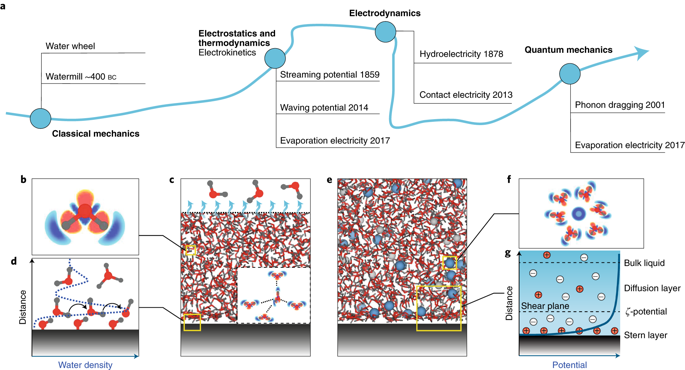Nature Nanotechnology ( IF 38.1 ) Pub Date : 2018-12-06 , DOI: 10.1038/s41565-018-0228-6 Zhuhua Zhang , Xuemei Li , Jun Yin , Ying Xu , Wenwen Fei , Minmin Xue , Qin Wang , Jianxin Zhou , Wanlin Guo

|
Water contains tremendous energy in a variety of forms, but very little of this energy has yet been harnessed. Nanostructured materials can generate electricity on interaction with water, a phenomenon that we term the hydrovoltaic effect, which potentially extends the technical capability of water energy harvesting and enables the creation of self-powered devices. In this Review, starting by describing fundamental properties of water and of water–solid interfaces, we discuss key aspects pertaining to water–carbon interactions and basic mechanisms of harvesting water energy with nanostructured materials. Experimental advances in generating electricity from water flows, waves, natural evaporation and moisture are then reviewed to show the correlations in their basic mechanisms and the potential for their integration towards harvesting energy from the water cycle. We further discuss potential device applications of hydrovoltaic technologies, analyse main challenges in improving the energy conversion efficiency and scaling up the output power, and suggest prospects for developments of the emerging technology.
中文翻译:

新兴的水力发电技术
水包含各种形式的巨大能量,但是这些能量中只有很少的一种被利用。纳米结构材料可以在与水相互作用时产生电能,这种现象我们称为水力发电效应,这可能会扩展水能收集的技术能力,并能够创建自供电设备。在这篇综述中,我们将从描述水和水-固体界面的基本特性入手,讨论与水-碳相互作用以及利用纳米结构材料收集水能的基本机制有关的关键方面。从水流,波浪,然后回顾了自然蒸发和水分,以显示其基本机理的相关性以及它们整合后从水循环中获取能量的潜力。我们将进一步讨论水力发电技术的潜在设备应用,分析提高能量转换效率和扩大输出功率的主要挑战,并提出新兴技术的发展前景。






























 京公网安备 11010802027423号
京公网安备 11010802027423号